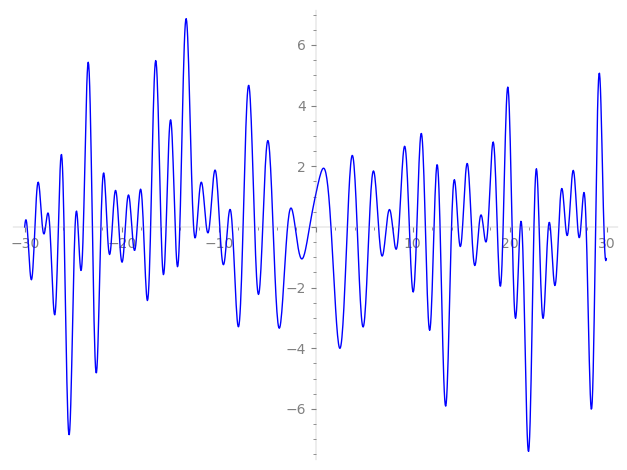| L(s) = 1 | + (−0.698 − 1.21i)2-s + (0.0229 − 0.0398i)4-s + (−0.198 − 0.344i)5-s + (1.69 + 2.02i)7-s − 2.85·8-s + (−0.278 + 0.481i)10-s + (0.824 − 1.42i)11-s − 13-s + (1.26 − 3.47i)14-s + (1.95 + 3.38i)16-s + (2.10 − 3.64i)17-s + (−2.54 − 4.40i)19-s − 0.0182·20-s − 2.30·22-s + (−1.20 − 2.09i)23-s + ⋯ |
| L(s) = 1 | + (−0.494 − 0.856i)2-s + (0.0114 − 0.0199i)4-s + (−0.0889 − 0.154i)5-s + (0.642 + 0.766i)7-s − 1.01·8-s + (−0.0879 + 0.152i)10-s + (0.248 − 0.430i)11-s − 0.277·13-s + (0.338 − 0.928i)14-s + (0.488 + 0.845i)16-s + (0.510 − 0.884i)17-s + (−0.584 − 1.01i)19-s − 0.00408·20-s − 0.491·22-s + (−0.251 − 0.436i)23-s + ⋯ |
\[\begin{aligned}\Lambda(s)=\mathstrut & 819 ^{s/2} \, \Gamma_{\C}(s) \, L(s)\cr =\mathstrut & (-0.805 + 0.592i)\, \overline{\Lambda}(2-s) \end{aligned}\]
\[\begin{aligned}\Lambda(s)=\mathstrut & 819 ^{s/2} \, \Gamma_{\C}(s+1/2) \, L(s)\cr =\mathstrut & (-0.805 + 0.592i)\, \overline{\Lambda}(1-s) \end{aligned}\]
Particular Values
| \(L(1)\) |
\(\approx\) |
\(0.332559 - 1.01386i\) |
| \(L(\frac12)\) |
\(\approx\) |
\(0.332559 - 1.01386i\) |
| \(L(\frac{3}{2})\) |
|
not available |
| \(L(1)\) |
|
not available |
\(L(s) = \displaystyle \prod_{p} F_p(p^{-s})^{-1} \)
| $p$ | $F_p(T)$ |
|---|
| bad | 3 | \( 1 \) |
| 7 | \( 1 + (-1.69 - 2.02i)T \) |
| 13 | \( 1 + T \) |
| good | 2 | \( 1 + (0.698 + 1.21i)T + (-1 + 1.73i)T^{2} \) |
| 5 | \( 1 + (0.198 + 0.344i)T + (-2.5 + 4.33i)T^{2} \) |
| 11 | \( 1 + (-0.824 + 1.42i)T + (-5.5 - 9.52i)T^{2} \) |
| 17 | \( 1 + (-2.10 + 3.64i)T + (-8.5 - 14.7i)T^{2} \) |
| 19 | \( 1 + (2.54 + 4.40i)T + (-9.5 + 16.4i)T^{2} \) |
| 23 | \( 1 + (1.20 + 2.09i)T + (-11.5 + 19.9i)T^{2} \) |
| 29 | \( 1 + 1.48T + 29T^{2} \) |
| 31 | \( 1 + (-1.92 + 3.34i)T + (-15.5 - 26.8i)T^{2} \) |
| 37 | \( 1 + (5.13 + 8.89i)T + (-18.5 + 32.0i)T^{2} \) |
| 41 | \( 1 - 4.65T + 41T^{2} \) |
| 43 | \( 1 - 8.47T + 43T^{2} \) |
| 47 | \( 1 + (2.02 + 3.51i)T + (-23.5 + 40.7i)T^{2} \) |
| 53 | \( 1 + (4.66 - 8.08i)T + (-26.5 - 45.8i)T^{2} \) |
| 59 | \( 1 + (0.827 - 1.43i)T + (-29.5 - 51.0i)T^{2} \) |
| 61 | \( 1 + (5.50 + 9.53i)T + (-30.5 + 52.8i)T^{2} \) |
| 67 | \( 1 + (-0.221 + 0.384i)T + (-33.5 - 58.0i)T^{2} \) |
| 71 | \( 1 - 9.74T + 71T^{2} \) |
| 73 | \( 1 + (3.32 - 5.76i)T + (-36.5 - 63.2i)T^{2} \) |
| 79 | \( 1 + (2.28 + 3.95i)T + (-39.5 + 68.4i)T^{2} \) |
| 83 | \( 1 + 16.4T + 83T^{2} \) |
| 89 | \( 1 + (-2.14 - 3.72i)T + (-44.5 + 77.0i)T^{2} \) |
| 97 | \( 1 + 8.26T + 97T^{2} \) |
| show more | |
| show less | |
\(L(s) = \displaystyle\prod_p \ \prod_{j=1}^{2} (1 - \alpha_{j,p}\, p^{-s})^{-1}\)
Imaginary part of the first few zeros on the critical line
−9.891725124744215100697864764786, −9.086659628530175257372583078157, −8.598055751910897807414781932672, −7.49118416682152610653611738517, −6.30118603403595851177718815398, −5.46380956277929115069534412510, −4.39674370082017402962640820544, −2.90352015848943345551188688543, −2.12333973836632410744537483471, −0.63293262364273537505731087706,
1.57256341663630810296447818063, 3.25907717351945556005868829302, 4.27291170546283172882785762863, 5.50584498043483242494168084077, 6.47717477461694833718946623950, 7.28092044539558153515754590741, 7.924835858478279485123565712569, 8.579054028424798411118412186424, 9.647909463957802686433130935632, 10.42285967506042509071611015954

